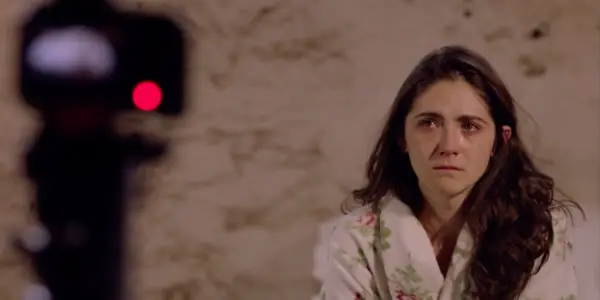TAPE: The Act Of Seeing Through Women’s Experience

Jax is a filmmaker and producer, and a film &…
Every once in a while, there is something that comes along and smacks you across the face. Sometimes it’s shocking, perhaps it’s the pure gall of what just took place, or sometimes it’s because it walks right up to you and whispers directly into your soul. Sometimes it’s all of that and none of it at the same time. Tape is one of the latter somethings.
The latest film from director Deborah Kampmeier, Tape tells the true story of two women whose lives are affected by a predatory purported talent agent in New York City. It is a departure for Kampmeier, in that the material originates with another person whereas her previous three films have all had the feeling of emanating from within Kampmeier herself. And yet, Tape also falls precisely upon Kampmeier’s trajectory, as it feels deeply personal and intimate. This dichotomy signals a growth in the director’s filmic narrative, one which seems to arrive at the perfect time.
Kampmeier’s previous film Split presents itself as almost the third piece in a trilogy, rounding off personal explorations Kampmeier also made in her first two films Virgin and Hounddog. With Split, Kampmeier took the opportunity to delve more into the emotional themes weaving themselves through the films and explored this in a more experimental nature. It leaves little left to explore further in the same vein. Now with Tape, Kampmeier takes her dominant themes, namely, women’s pain and the connection of speaking our truth to healing that pain, and attacks them from a new, more objective angle.
It is this simultaneous objectivity and subjectivity that lifts Tape beyond being ‘just another’ story of blurred lines, the grey area of rape, and brings it neatly into the realm of truth and experience. It is in this subjective objectivity that Kampmeier loses the male gaze.

Not To Gaze Upon
The concept of the “male gaze” was developed by Laura Mulvey and posits that, in cinema, the camera expresses ‘sight’ through a masculine perspective, that is to say, a scopophilic perspective, one which derives pleasure from looking. Gaze theory gets complex, contradictory, and lengthy, but one argument for the “female gaze” is that, essentially, it becomes the same as the “male gaze” because women are socialised into seeing themselves and others from a male perspective. This is why you get filmmakers putting in lots of male genitalia in Game of Thrones to supposedly balance all the female nudity. It is therefore significant when Kampmeier says in her interview for Film Inquiry recently that she is not interested in the “female gaze” but rather the “female experience”. So let’s look at that and what that might mean in context. Does Kampmeier achieve this in Tape?
Kampmeier worked with cinematographer Valentina Caniglia on Tape, and between them, they’ve created an aesthetic that is contained and oscillates between frenetic and stoic. The act of seeing without using one’s own eyes becomes a key element through the diegetic use of multiple video cameras (this accounts for the frenetic). Meanwhile, the act of seeing through Kampmeier’s eye is accounted for by the main (or director’s) camera. Neither of these viewpoints are male-dominated.

However, there is a twist on the male gaze in the use of the diegetic cameras – these are watched (gazed upon) by Annarosa Mudd’s character Rosa but not in pleasure, rather in pain. These cameras are close, tight, intimate and secret to the two characters they focus on (Isabelle Fuhrman’s Pearl and Tarek Bishara’s Lux). Kampmeier’s director’s camera connects the three characters, but she primarily uses this to show us Rosa, instead relying more heavily on Rosa’s gaze-cameras to bring us into the space with Pearl and Lux. It is through those cameras that the film’s rape scene is relayed to both Rosa and the viewer, and in this, there is a connection between Kampmeier’s previous film catalog and Tape, thereby also connecting the subjective and objective viewpoints Kampmeier balances in Tape.
Pearl’s rape occurs on-screen almost entirely through the lens of an in-film hidden camera placed in a clock. This clock points directly at Pearl’s face (except for when it’s knocked to the floor and sees nothing). This shot is reminiscent of the way Kampmeier shot the rape scene in Hounddog – a shot high above Dakota Fanning’s Lewellen leaves us exclusively in her experience of the trauma. As there, in Tape the trauma is expressed solely through the shared experience of Pearl and Rosa (for Rosa, too, is a victim of Lux). It is in this honest and haunting expression of women’s experience – indeed, women’s trauma – that Tape, and indeed Kampmeier’s entire filmic work, finds its strength.
Indie Vibes
Despite the strides made by #MeToo, #TimesUp, and the Weinstein conviction, mainstream Hollywood is not ready for such stories so it’s unsurprising that Tape is a labor of love. It results yet another dichotomy in the film – it feels fresh, energetic, and outspoken in a way only an independent film really does, but at the same time can, on occasion, feel less “finished” than say a multi-million dollar blockbuster. This only really matters if you look at the film comparatively to said blockbusters, which is arguably not the right approach. If instead, you take on a film for what it is saying, for what it leaves you with, and for how grateful you are for having spent the time to watch it, then you are far better off and will find far more quality work.

Ever more the notion after watching a film, particularly Oscar-baity Hollywood darlings, is “What was the point of that?” Kampmeier makes her point loud and clear, and goes out of her way to be inclusive in her point. This is not just another white feminist preaching to the choir from the pulpit. The film’s indie status allows Kampmeier great control, and she uses that to ensure a representation of all women’s pain, which is expressed most clearly in the scene of the circle of women all simultaneously retelling their own stories of trauma.
This is a reprise from Split and is just as effective here in Tape, but it is absolutely something a Hollywood exec would shoot down in an instant. It comes from nowhere (but as we women know, it comes from everywhere), it’s arguable that it breaks the fourth wall, and it is not remotely PC nor should it be.
Tape had its virtual premiere at tapevirutalpremiere.com and will be available for digital download on April 10th 2020.
Does content like this matter to you?
Become a Member and support film journalism. Unlock access to all of Film Inquiry`s great articles. Join a community of like-minded readers who are passionate about cinema - get access to our private members Network, give back to independent filmmakers, and more.
Jax is a filmmaker and producer, and a film & tv production lecturer at the University of Bradford and is also completing a PhD about Stan Brakhage at the University of East Anglia. In the remaining "spare time", Jax organises the Drunken Film Fest, binges bad TV, and dreams of getting “Bake Off good” with their baking.













